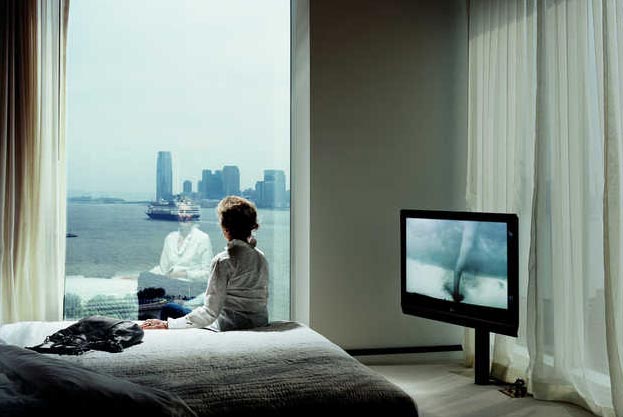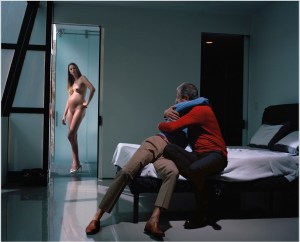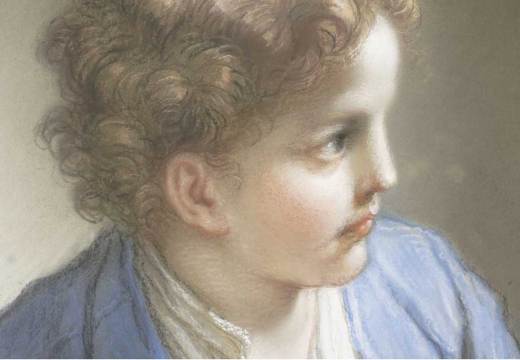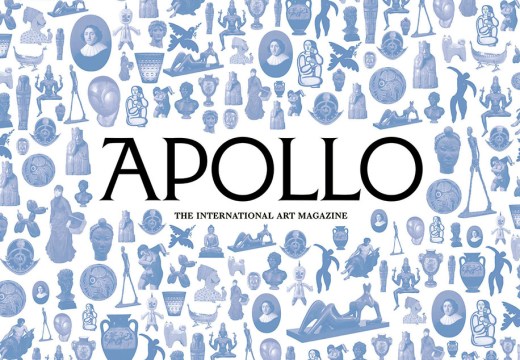Philip-Lorca diCorcia’s current London exhibition is nothing if not serious. New and recent photographs have been brought together in ‘East of Eden’ – a title borrowed from John Steinbeck’s magnum opus of a novel, and equally evocative of the 1955 film starring James Dean. The phrase has its genesis in Genesis: after murdering his brother, Cain travelled into the ‘Land of Nod, on the east of Eden’, the King James Bible tells us. But it will forever conjure images of modern America, caught between utopia and dystopia, and the image of the saturnine Dean, dual hero and anti-hero.
DiCorcia sets out to do something similar, transporting us into pockets of American suburbia or into a rural California that might also be a scriptural no-man’s-land. Cain and Abel (2013) shows two clothed men embracing (or tussling) on a bed in a drab motel room. A woman looks askance from an illuminated doorway, naked and pregnant. The scene resembles a film still or snapshot of a stage play, a moment cut loose from a narrative; but what narrative? The title fudges meaning as much as it supplies it: the press release reveals that these are not fighting brothers but a gay couple observed by ‘a modern-day Eve’.
DiCorcia summons up familiar narratives only to hold them at arm’s length. His works harbour a strange tension between staginess and candour. In Abraham (2010) a young man stands in the doorway of a wooden hut. DiCorcia’s arm encroaches from the left, and a red dart hovers mid-air between them. Will it hit the boy or land on the dartboard hanging beside him? The boy’s impassive expression offers no clues. There is a mood of uncertainty here similar to that in paintings showing Abraham about to murder Isaac, just as God calls a halt (everything’s fine, it was all a game).
We are required, it seems, to embroider the photographs with narratives, whether real or fictional. Midway through my visit, I encountered a tour led by Martin Barnes – photography curator at the V&A – who supplied some of the missing context. ‘Isaac’, it turns out, is diCorcia’s son. Another work, Mr Briggs (2007-8), shows a man lying in a glass capsule in hospital overalls, watching television. It transpires that Mr Briggs is a boxer who prepared for a fight by lying in a highly-oxygenated compression chamber. He lost the fight – clearly it wasn’t worth the trouble. And perhaps this information is only so useful. Without it, Mr Briggs is at once a calmly passive patient and a prisoner or scientific specimen; meaning hovers unfixed like the airborne dart.
Obliqueness, understatement – these attitudes are played out, almost caricatured, by diCorcia. Certain images owe much to William Egglestone and the set-piece ‘film stills’ of Gregory Crewdson. Where there is humour, it is heavy-handed – mirthless in its wit. In The Hamptons (2008) a widescreen TV playing porn is watched by dogs – they are mesmerised (if only momentarily) by the doggy-style rutting.
Viewers may bridle at the purse-lipped ponderousness of diCorica’s images, but they strike a note of epic that is out of synch with most contemporary ‘photography as high art’ (Crewdson seems tricksy by comparison). The lack of irony and unflinching solemnity are part of their calculated aesthetic froideur. Reality has been restaged in deliberately brittle terms. Through their very restraint, the photographs become saturated with tension, unease, even melancholy (medieval painting is affecting in just the same way – eloquent by dint of its woodenness). Refuting the notion of documentary photography – what photograph, after all, is free of contrivance? – diCorcia’s camera doesn’t quite lie, but only gives so much away.
‘Philip-Lorca diCorcia: East of Eden’ is at David Zwirner, London, until 16 November 2013.
Unlimited access from just $16 every 3 months
Subscribe to get unlimited and exclusive access to the top art stories, interviews and exhibition reviews.















![Masterpiece [Re]discovery 2022. Photo: Ben Fisher Photography, courtesy of Masterpiece London](http://www.apollo-magazine.com/wp-content/uploads/2022/07/MPL2022_4263.jpg)
Is the Stirling Prize suffering from a case of tunnel vision?